1. Retail Package - Installation
TDK 1616N Recorder -
Page 1
 Most
manufacturers have recently released DVD recorders supporting 16X DVD writing.
TDK follows suit with their latest DVD recorder, the TDK1616N. This
drive offers 16X +R/-R recording speed, along with Double Layer recording at
4X,
the maximum speed available at the moment.
Most
manufacturers have recently released DVD recorders supporting 16X DVD writing.
TDK follows suit with their latest DVD recorder, the TDK1616N. This
drive offers 16X +R/-R recording speed, along with Double Layer recording at
4X,
the maximum speed available at the moment.
 The
TDK 1616N takes advantage of NEC's "high resolution writing strategy", as was
the case with the TDK 880 and 882 models.
The
TDK 1616N takes advantage of NEC's "high resolution writing strategy", as was
the case with the TDK 880 and 882 models.
- Features
 The
TDK 1616N can read at 16X max DVD-ROM discs and 48X max CD-ROM discs. It can
write
at 16X for both -R and +R DVD media, and can write/rewrite at 4X in
-RW and +RW discs. The recording speed for DVD+R9 discs reaches 4X. As a CD
recorder,
it can record at 48X max when CD-R discs are used, and 24X max with CD-RW discs.
Unfortunately, this drive does not support DVD-RAM media.
The
TDK 1616N can read at 16X max DVD-ROM discs and 48X max CD-ROM discs. It can
write
at 16X for both -R and +R DVD media, and can write/rewrite at 4X in
-RW and +RW discs. The recording speed for DVD+R9 discs reaches 4X. As a CD
recorder,
it can record at 48X max when CD-R discs are used, and 24X max with CD-RW discs.
Unfortunately, this drive does not support DVD-RAM media.
- Specifications
Drive |
TDK 1616N |
Media |
DVD |
CD |
Transfer Rate Write |
+R |
16x CAV (9 - 22MBytes/sec)
|
-R |
48x CAV (3000-200kBytes/sec) |
13x CAV (7.3 - 17.5MBytes/sec) |
48xZCLV (3000-7200kBytes/sec) |
12x ZCLV (8.2 – 16.6MByte/sec) |
40x CAV (2550-6000kBytes/sec) |
8x ZCLV (5.5 -11MBytes/sec) |
40xZCLV (3000-6000kBytes/sec) |
6x ZCLV (5.5-8.2MBytes/sec) |
32xPCAV (2550-4800kBytes/sec) |
4x CLV (5.5 MBytes/sec) |
32x ZCLV (3000-4800kBytes/sec) |
2.4x CLV (3.3 MBytes/sec) |
24x PCAV (2550-3600kBytes/sec) |
+R9 |
4x CLV (5.5 MBytes/sec) |
24x ZCLV (3000-3600kBytes/sec) |
2.4x CLV (3.3 MByte/sec) |
16x CLV (2400kBytes/sec) |
+RW |
4x CLV (5.5 MBytes/sec) |
8x CLV (1200kBytes/sec) |
2.4x CLV (3.3 MBytes/sec) |
-RW |
24x ZCLV (3000-3600kBytes/sec) |
-R |
16x CAV( 9 - 22MBytes/sec) |
13x CAV (7.3 - 17.5MBytes/sec) |
12x ZCLV (8.2 – 16.6MByte/sec) |
16x CLV (2400kBytes/sec) |
8x ZCLV (5.5 -11MBytes/sec) |
6x ZCLV (5.5-8.2MBytes/sec) |
4x CLV (5.5 MBytes/sec) |
10xCLV (1500kBytes/sec) |
2x CLV (2.7 MBytes/sec) |
-RW |
4x CLV (5.5 MBytes/sec) |
2x CLV (2.7 MBytes/sec) |
4xCLV (600kBytes/sec) |
1x CLV (1.38 MBytes/sec) |
Transfer Rate Read |
DVD-R 16x CAV (max 22000 kb/s) |
CD-R 48x CAV (max 4800 kb/s) |
DVD-RW 4x CLV (5520 kb/s) |
DVD+R 16x CAV (max 22000 kb/s) |
CD-RW 16x CLV (max 2400 kb/s) |
DVD+RW 4x CLV (5520 kb/s) |
DVD+R9 4X CLV (5500 KByte/s) |
Access Time |
140ms |
120ms |
Mechanism |
motorized Tray load mechanism for horizonal and vertical use |
Interface |
IDE / ATAPI |
Burst Transfer Rate |
PIO mode 4 / Ultra DMA 33 |
Cashe Memory |
2MB |
Audio |
digital-out and line-out at the back (MPC compatible) |
Modes supported |
DVD-ROM, DVD-R, DVD-RW, DVD+R, DVD+RW, DVD-Video, CD-ROM, CD-ROM XA, CD-Audio, CD Extra, CD Text, CD-IReady, CD-Bridge, Photo-CD, VideoCD, Hybrid CD |
Writing methods |
DAO(disc at once), SAO(session at once), TAO(track at once) with zero gap, variable or fixed packet, multisession |
Compatibility |
MPC Level 3, MultiRead, PC2001 |
Weight |
1.01 kgr |
Dimensions |
148mm x 42mm x 190mm |
The drive does not support Mount Rainier and it uses the well known RPC II region control, allowing a user to change the drive's region at most 5 times. Below are the drive's main specs as given by NeroInfoTool. VSO Inspector and DVDInfoPro:
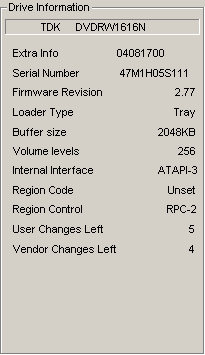
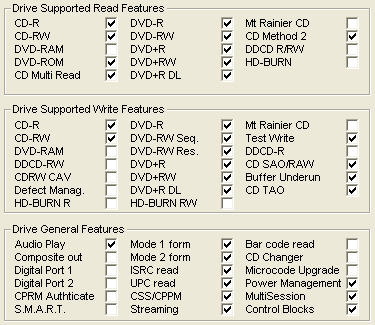

- The drive
The European retail package includes a software disc, software manual, technical
support manual, quick install poster, screws, emergency eject pin
and a TDK DVD+R 4.7GB disc.

The retail ackage also includes Nero Express 6, Nero InCD 4, Nero Vision Express 2, Nero Back IT Up, Nero StartSmart, Nero Recode 2 and Nero Showtime.

On the front panel of the drive you can see the eject button, the activity
led and the eject hole. There are no volume control or headphone jack.

On the rear panel you can find the analogue and digital audio outputs (SPDIF),
the IDE selection pins, the IDE connector
and the power input.

Opening the device's case will void the warranty, so we advise against it. Instead, use the photos in this review for a closer look under the hood. Clicking on the image below will reveal a high resolution image.
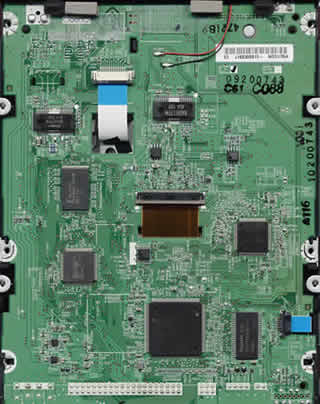
The main chipset comes from NEC, with part number NEC
D63635GM in combination with the NEC C333500. The same chipsets are used in
the Pioneer DVR-108
and ASUS DRW-1604P.


Model name |
C3335 |
Process |
Bi-CMOS 0.35 |
Voltage |
5V |
Package |
120-pin TQFP (14x14mm) |
Power consumption |
0.66W (8x DVD playback) |
0.74W 8x DVD recording) |
Speeds |
DVD playback |
16x CAV |
DVD-RAM playback |
4x |
DVD recording |
16x |
CD playback |
48x |
CD recording |
48x |
Model name |
D63635 |
Process |
CMOS 0.15 |
Voltage |
1.5V core, 3.3V I/O |
Package |
216-pin LQFP (24x24mm) |
Power consumption |
0.35W (8x DVD playback) |
0.95W (8x DVD recording, LVDS) |
Interface |
Host |
ATA/ATAPI5 |
Buffer |
16Mbit SDRAM |
Speeds |
DVD playback |
16x CAV |
DVD-RAM playback |
4x |
DVD recording |
16x |
CD playback |
48x |
CD recording |
48x |
The following picture shows the laser lens assembly of the TDK 1616N. By clicking
on the picture, you can see a higher resolution image.
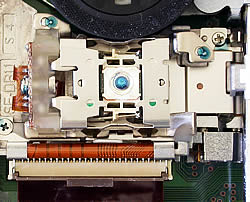
Compared to TDK
882N laser lens, you can see that the new laser lens is more advanced,
achieving higher single layer and double layer recording speeds.
- Installation
The device was connected to our test PC and was identified
as "TDK DVDRW116N " under
WinXP. You can see that there is no book type option, just as the TDK 882N,
and there is no option to write extended Lead-Out on Double Layer discs. All
tests were done using the 2.77 firmware version, released by TDK.

In this review, we will be comparing the drive to the Pioneer DVR-108
since both drives have similar specifications.
- Testing software
In order to perform our tests we used:
- Nero CD-DVD Speed v3.21
- CDVD Benchmark v1.21
- ExactAudioCopy v0.9 beta5
- Nero Info Tool v2.27
- KProbe v2.4.2 (Reader: LiteOn LDW-811S firmware vHS0Q, LiteOn SOHD-167T firmware 9S13, LiteOn XJ-HD165H firmware CH11, and LiteOn LTD-163 firmware GH5S, Reading speed 8X CAV)
- PlexTools v2.16 (Reader: Plextor PX-712A firmware v1.05, Reading speed 8X CLV for CD-R)
- DVDInfoPro v3.16
- Nero Burning Rom v6.3.1.20
- DVD Decrypter 3.5.1.0
- CopyToDVD 3.0.29.48
2. Transfer Rate Reading Tests
TDK 1616N Recorder - Page 2
Transfer Rate Reading Tests
- CD Format
The TDK 1616N supports up to 48X reading speed. Below are the transfer rate
graphs along with the comparison with the Pioneer DVR-108 drive:



The TDK 1616N proved to be faster than the Pioneer model with Pressed CDs,
CD-R media and US-RW media.
- DVD Format

When pressed single layer media was used, the Pioneer DVR-108
and TDK 1616N reported similar reading speeds.
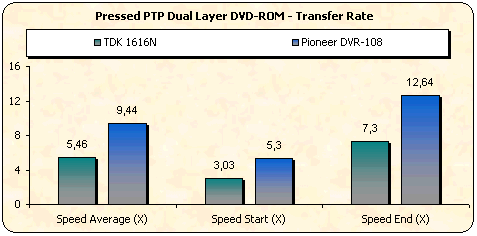
The two layers of a PTP DVD-ROM disc are read sequentially
with the drive starting reading from the inner part of the disc, which is the
beginning of each layer, progressing towards the outer range for each layer.
The TDK 1616N was slower than the Pioneer DVR-108 with a
noticable difference in speeds.
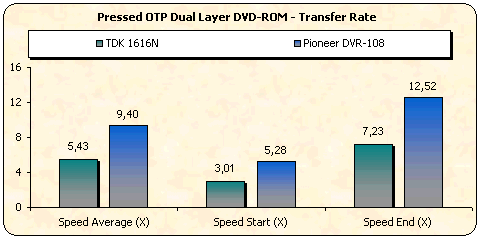
The first layer of an OTP dual layer DVD-ROM is read exactly
the same way as the first layer of the PTP disc we tested previously. The difference
here is the reading strategy of the second layer on the disc. The beginning
of the second layer is located in the outer part of the disc, so the drive
starts reading from the outer tracks towards the inner part of the disc. The
average reading speed was 5.43X with a start speed of 3.01X and
end speed of 7.23X. These speed values indicate minor variations
from the
speeds reported by the TDK 882N drive, and are lower than the DVR-108 speed
values.


The TDK 1616n can read DVD ±R media up to 16X and DVD ±RW
up to 8X. That makes the TDK 1616n one of the fastest readers for ±R
media. The Pioneer DVR-108 cannot compete with 8X CAV reading speed for all
DVD recordable/re-writable
media.

The TDK 1616N reported an average ripping speed of 5125kb/sec with DVD-Video
discs, and proved to be slower than Pioneer's drive when it comes to DVD Video
ripping.
Nero CD-DVD Speed Graphs
3. CD Error Correction Tests
TDK 1616N Recorder -
Page 3
CD Error Correction Tests
In the following tests we check the drive's behavior when reading
scratched / defective audio discs. The test discs used were the ABEX series
from ALMEDIO.
- ABEX TCD-721R

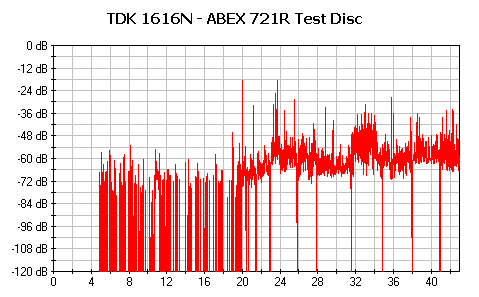
|
Errors
total
|
Num:
1367028
|
|
Errors
(Loudness) dB(A)
|
Num: 134807 |
Avg:
-79.2 dB(A) |
Max:
-18.6 dB(A) |
|
Error
Muting Samples
|
Num: 4939 |
Avg:
1.1 Samples |
Max: 7 Samples |
|
Skips
Samples
|
Num: 23 |
Avg:
6.0 Samples |
Max:
6 Samples |
Total Test Result |
65.4 points (out of 100.0 maximum) |
|
C2 Accuracy |
99.0 % |
The total error count was about average, and the maximum error loudness level
was high at -18.6dB. There were 23 skipped samples
which is a little high, while
the drive
achieved a total score of 65.4. In general, the drive showed average performance
with this test disc.
- ABEX TCD-726


|
Errors total
|
Num:
21991
|
|
Errors (Loudness) dB(A)
|
Num: 7339 |
Avg:
-83.2 dB(A) |
Max:
-14.5 dB(A) |
|
Error Muting Samples
|
Num: 133 |
Avg:
27.9 Samples |
Max:
575 Samples |
|
Skips Samples
|
Num: 2 |
Avg:
6.0 Samples |
Max: 6 Samples |
Total Test Result |
73.5 points (out of 100.0 maximum) |
C2 Accuracy |
81.9 % |
The Abex TCD-726 test disc is much easier for drives in general to read. Most
drives manage to compile a score in the 90s with the better drives managing
100. So it was somewhat surprising to see the drive managing only 73.5. A good
reader
should produce better results than these.
- CD-Check Audio Test Disc
 The CD-Check Test Disc is a very useful tool for evaluating the Sound Reproduction
/ Error correction capabilities of a CD player. The disc offers a signal combination
with disc error patterns to rate the drive's abilities to read music and reproduce
it completely. Five tracks on the disc contain a sequence of progressively
more difficult tests. These tracks are referred to as Check Level-1 through
Check Level-5.
The CD-Check Test Disc is a very useful tool for evaluating the Sound Reproduction
/ Error correction capabilities of a CD player. The disc offers a signal combination
with disc error patterns to rate the drive's abilities to read music and reproduce
it completely. Five tracks on the disc contain a sequence of progressively
more difficult tests. These tracks are referred to as Check Level-1 through
Check Level-5.
The
tracks are being reproduced through a software multimedia player (i.e.
Windows Media Player). Each level is considered as passed, if the tone
is smooth, continuous without interruptions, skipping or looping. The higher
the Check Level passed, the more reliable the sound reproduction
of the tested drive.
|
Error Level
|
1
|
2
|
3
|
4
|
5
|
|
|
5/5
|
5/5
|
3/5
|
0/5
|
0/5
|
The drive successfully passed only the first two out of the five check levels
for this test. Here too, the drive turned in a poor performance. Almost
all drives have difficulties reading the 5th level, and good quality drives
can
read 4th
level. But most drives will pass at least the third level without any problem.
The TDK 1616N reported similar performance as the 882N drive.
- Summary
Generally we can say that the CD error correction of the TDK 1616N is less
than average, something that should be fixed in newer firmware releases.
4. DVD Error Correction Tests
TDK 1616N Recorder -
Page 4
DVD Error Correction Tests
In the following tests we examined the DVD reading capabilities of the TDK 1616N drive with scratched / defective DVD media. For the tests we used CDVD Benchmark and Nero CDSpeed . The reference test media comes from ALMEDIO.
- Single Layer media
ABEX TDR-821
This is a single sided, single layer DVD-ROM with a 4.7GB capacity, and its surface has an artificial scratch of dimensions varying from 0.4 to 3.0 mm.

The following transfer rate picture comes from the CDVD Benchmark v1.21 transfer rate test.

The drive can read DVD media up to 16X. No errors were produced
with this disc. However, the drive lowered its speed in order to read over
the scratched area.
ABEX TDR-825
This is also a single sided, single layer DVD-ROM of 4.7GB
capacity. The data structure of the disc is exactly the same as that of the
TDR-821, with the difference that there are no scratches on it but instead,
defective areas of dimensions ranging from 0.5 to 1.1 mm.

There are also fingerprints sized from 65 to 75 micrometers.
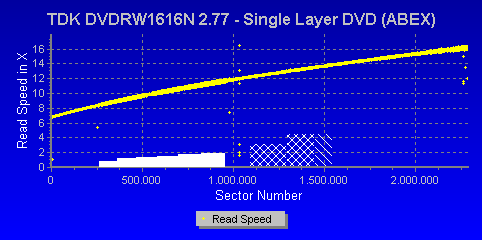
Again, the TDK 1616N reported no errors with this test disc. A continuous
line was produced, showing that the drive had no problems reading the defective
areas.
- Dual Layer media
ABEX TDR-841
This is an 8.5GB dual layer, single sided DVD-ROM disc with artificial scratches
of dimensions ranging from 0.4 to 3.0mm, on both layers.
. 
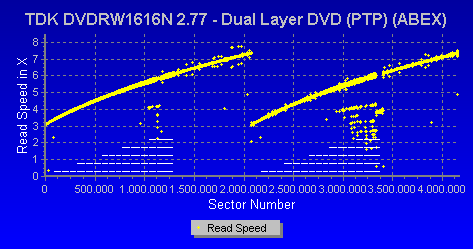
Most NEC based drives have problems reading this type of disc. As seen above,
TDK has improved the DVD error correction, where the drive gave no errors
during reading. The test was completed successfully. Excellent performance
at this
point!
ABEX TDR-845
The disc is a single sided, dual layer DVD-ROM disc with a capacity of 8.5GB. The only difference between the TDR-845 and the TDR-841 is that the first includes defective areas and fingerprints. The dimensions of the defective areas range from 0.5 to 1.1 mm and the
fingerprints are sized from 65 to 75 micrometers.


Again, the drive had no problems reading this disc. The 1616N read the disc
as if there were no defective areas present.
ABEX TDV-541
The TDV-541 is a single sided, dual layer DVD-VIDEO disc, with a capacity
of 8.5GB. The disc is based on the TDV-540 series which is designed for inspection
and adjustment of DVD-VIDEO players. The disc checks the layer switch operation
from layer 0 to layer 1 and also includes test pictures and test signals for
DVD sound files.

The current TDV-541 also checks the error correcting capabilities of
the drive and includes scratches from 0.4 to 3.0 mm.

As is evident above, the TDK 1616N read the disc flawlessly. According
to this reading behaviour, the drive can be described as a rather
good reader.
It started to read at 1.92X, lowered the reading speed automatically when needed
and reached a highest reading speed of 4.61X, resulting in an average
speed of 3.24X.
ABEX TDV-545
The TDV-545 disc is based on the TDV-540 series. It is a single sided, dual layer DVD-VIDEO disc with a capacity of 8.5GB. The TDV-545 includes artificial black dots on the data surface, sized from 0.4 to 1.0 mm. It has also 65 - 75 micro meter fingerprints.


The TDK 1616N started to read at 1.92X, and reached a highest speed of
4.61X, giving the same speed values as before. Although the reading speed was
not as high
as other 8X DVD recorders, we were happy to see that no read errors were produced.
5. Protected Disc Tests
TDK 1616N Recorder - Page 5
Protected Disc Tests
- Reading Tests
To create the image of the various protected titles to the hard disk, we used Alcohol 120% software and the appropriate settings, according to the protection type of the inserted discs. Below you can see the duration of each process as well as the transfer rate in each case.
Game Title |
Protection Scheme |
Duration |
Reading speed |
PSX "NBA Jam Extreme" |
Lybcrypt |
01:07 min |
1349 sectors/sec |
Serious Sam The Second Encounter v1.07 |
SafeDisc v.2.60.052 |
32:56 min |
170 sectors/sec |
VRally II |
SecuROM v.2 |
3:09 min |
1819 sectors/sec |

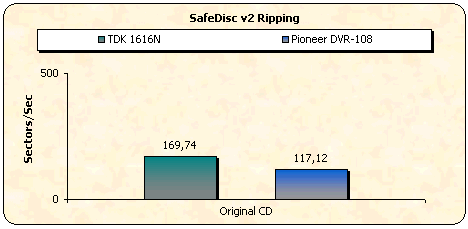

The TDK 1616N was very fast with Lybcrypt protected discs. During SecuROM
v2 ripping, the drive was slightly faster than the Pioneer DVR-108 drive. On
the
other hand, the Pioneer drive was faster with SecuROM v2 protected discs. However,
all discs were read successfully, regardless
of the ripping speed.
- Writing Tests
The TDK 1616N supports the DAO-RAW writing mode. For checking the drive's
EFM correction status, we used 5 different game titles with different SafeDisc
2 versions having the latest software patches installed. After making the images
of the various titles onto the hard disk, we burned them (maximum speed) with
Alcohol 120% v1.9.2.1705. Two different discs were created for each title;
one with the "Bypass EFM error" enabled and one more with the function
disabled.
- Fifa 2004 - Safe Disc v3.1x
- The Sims Superstar - Safe Disc v2.9x
- The Sims Unleashed - Safe Disc v2.8x
- Serious Sam Second Encounter - Safe Disc v2.51.021
- Max Payne - Safe Disc v2.51.020
The table below shows the results of the attempted backups and whether they worked (game installed / played normally), or not.
Drive |
Fifa 2004
SD v3.1 |
Sims Superstar SD v2.9 |
Sims Unleashed SD v2.8 |
Serious Sam-Second Encounter
SD v2.51.051 |
Max Payne
SD v2.51.020 |
EFM OFF |
EFM ON |
EFM OFF |
EFM ON |
EFM OFF |
EFM ON |
EFM OFF |
EFM ON |
EFM OFF |
EFM ON |
Toshiba
SD-M1502 |
No |
No |
No |
Yes |
No |
Creative CD5233E |
No |
No |
Yes |
No |
TDK 1616N |
Yes |
No |
Yes |
Yes |
The TDK 1616N cannot produce working backups with the newest v2.8x, v2.9x
and v3.1x builds. Partially working backups were produced for SafeDisc v2.51.051 & v2.51.020.
It is noted that this behaviour is common to all NEC chipset based drives.
6. DAE Tests
TDK 1616N Recorder -
Page 6
DAE Tests
- Pressed and CDR AudioCD results
The TDK 1616N supports up to 13-32X CAV DAE speed. The following results were reported when using Exact Audio Copy.

The TDK 1616N was slower with both Pressed CD and CDR media. TDK's drive
reported similar DAE speeds with NEC's ND-25x0 series and TDK's 882N drives.
The TDK 1616N
drive can report C2 errors, but caching is not supported.

- Advanced DAE Quality


Very good recorders can achieve a perfect quality score of 100. The TDK
1616N achieved a score of 99.1, which is a very good score (but not perfect)
while the Pioneer DVR-108's average speed was faster
than that of the TDK 1616N. The TDK drive cannot read Leadin data and Leadout
data, but it can read CD Text and Subchannel data. The reported average speed
was
24.30X.
Again, the drive reported similar behaviour with the TDK 882N drive.
- Ripping 90mins AudioCDs

The drive can read/rip flawlessly 90min Audio CDs at an average speed of
23.17X, starting the reading process at 15.38X and reported a maximum speed
of 32.97X. Reading speed was automatically reduced near the end of the
reading
process, from the 77th min to the end and the drive read the
disc without errors.
- Ripping 99mins AudioCDs
The TDK 1616N could not even recognize the 99min Audio CD we used for this
test. The time length was wrong and the reading process could not start, giving
the following error message.


It should be noted that 99min Audio CDs were a problem with all NEC
based drives.
7. Protected AudioCDs
TDK 1616N Recorder -
Page 7
Protected AudioCDs
For the test procedure we used three audio discs with different audio copy
protections. The ripping process on all protected Audio discs was carried out
with Exact Audio Copy v0.9 beta5.
The tested protected Audio discs were:
- Sony's Key2Audio from "Celine Dion - New Day Has Come"
- Cactus Data Shield 200 from "Natalie Imbruglia - White Lilies Island"
The Cactus Data Shield 200, contains artificial errors that are not easily
bypassed by the reader, while the Key2Audio contains a second session causing
problems for readers when trying to read the Table Of Contents (TOC).
The tested tasks are:
- Recognition of the inserted disc (Yes/No).
- Ripping all wavs (with EAC's Burst Mode) to the hard disk with copy&compare function.
- Listening to the produced wavs for any click/skips.
The drive recognized up to the 12th Audio track of the CDS200 disc,

and with the "Retrieve Native TOC" option removed, the drive recognised
the 13th track.

The test results are shown in the following table:
|
Key2Audio |
CDS200 |
TDK 1616N |
Ripping process completed, EAC reports no problems, Read&Test CRC comparison successful for all tracks |
Ripping process completed, EAC reports no problems, Read&Test CRC comparison not the same for all tracks |
The TDK 1616N rips 100% accurately Key2Audio protected CDs. EAC did not
report timing problems, and at the same time, Read&Test CRC check comparison
was the same for all corresponding tracks. On the other hand, the drive could
not rip 100% accurately CD200 discs since Read&Test CRC check comparison
was not the same between corresponding tracks.
- Cactus Data Shield 200.0.4 - 3.0 build 16a (Aiko Katsukino - The Love Letter)
 This is a "special" CDS200 build, since it doesn't contain any artificial errors during the ripping process. Most problems occur when trying to write the ripped wav files, since the produced CD-R disc contains C2 and CU errors! This "problem" is rumored to be connected with specific chipset weaknesses.
This is a "special" CDS200 build, since it doesn't contain any artificial errors during the ripping process. Most problems occur when trying to write the ripped wav files, since the produced CD-R disc contains C2 and CU errors! This "problem" is rumored to be connected with specific chipset weaknesses.
We ripped the disc contents with EAC and burned the wav file produced from the Cactus Data Shield 200.0.4 - 3.0 build 16a disc with the latest Nero version as AudioCD+CD-Text. The burned media was checked for C1/C2 errors and for BETA/Jitter errors with PlexTools software using Plextor PX-712SA (firmware v1.05).
|
CDS 200.0.4 - 3.0 build 16a |
TDK 1616N |
Reading performed without any errors, writing produces only two C2 errors. |
- C1C2 Error rate from PleXWriter PX-712SA (8X CLV reading speed)

- BETA/Jitter Error rate from PleXWriter PX-712SA

The C1/C2 error graphs show that the drive managed to produce a 100% error
free disc.
We then tried to extract all wav files with the Plextor PX-712SA and PlexTool DAE Error Correction 5th Level enabled:

No errors were reported after extracting all files. The drive can backup the
disc 100% accurately.
8. CD Recording Tests
TDK 1616N Recorder - Page 8
CD Recording Tests
- CD-R Format
The TDK 1616N probably has the highest combination of writing speeds and
writing technologies supporting the following writing speeds:
- 8X and 16X CLV
- 24X Z-CLV, 24X P-CAV
- 32X Z-CLV, 32X P-CAV
- 40X Z-CLV, 40X CAV
- 48X Z-CLV, 48X CAV
It's rather uncommon for a drive manufacturer to support
both Z-CLV and P-CAV/CAV writing technologies for the same writing speeds,
but depending on the media manufacturer the drive the adjusts accordingly
to produce the best possible results.

According to Nero CDSpeed, the drive reached a maximum speed of 47.98X.
The test started at 21.43X and finished at 47.98X having an average speed
of 36.25X.
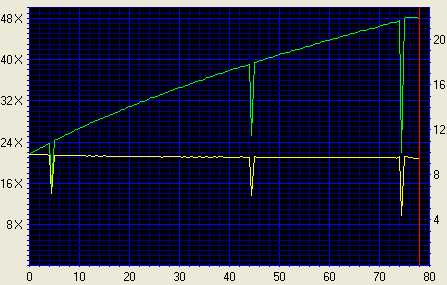
- CD-R Recording Times
We created an 80min data compilation with Nero Burning Rom and recorded
it on a 700MB disc. The writing performance varies according to the inserted
media. Below is a chart depicting all recording times with
various media.

The TDK drive returned a time of 3:34 minutes at 32X
writing speed when Intenso 52X media was used, and 3:01 at
48X writing speed when BenQ 52X media was used. Very good performance at
this speed. It should be noted that all media was recorded at maximum supported
speeds by the drive.
- Other features
The TDK 1616N supports overburning up to 88mins at full speed and can read/write
CD-Text.

- CD-RW Format
The TDK 1616N supports 4X, 10X, 16X (CLV) and 24X (Z-CLV) rewriting speeds,
with Ultra Speed Rewritable Media
(US-RW).
Below you can see the Nero CD-DVD Speed writing simulation test with blank 24x US-RW media from Mitsubishi Chemicals.
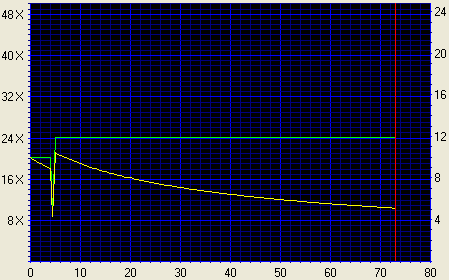
- CD-RW Mount Rainier
Unfortunately, the TDK 1616N does not support the Mount Rainier feature.
9. Writing Quality Tests - 3T Jitter Tests
TDK 1616N Recorder - Page 9
Writing Quality Tests - 3T Jitter Tests
On this page we present the 3T Pit & Land Jitter graphs when
using various media burned at 32X and 48X writing speeds.
- 3T Pit results

Generally, mediocre performance was reported with the 1616N drive. The
highest 3T Pit jitter reached 55nsec, which is way above the Red Book limit
(35nsec).
Best results were achieved with BenQ CD-R media. TDK should improve the CD
media recording performance in a future firmware release.

- 3T Land results

Here too, the average 3T Land results were also high. The maximum 3T
Land Jitter
reached 55nsec while BenQ CD-R media produced the best results.

According to the above graphs, the TDK 1616N did not produce the results
we expected, going on to the good performance of former NEC based drives.
On the other hand, when writing at 32X, recording quality was far better, but
when writing at 48X, media quality was reduced. It should be noted that all
discs were recorded at the maximum supported speeds.
10. Writing Quality Tests - C1 / C2 Error Measurements
TDK 1616N Recorder - Page 10
Writing Quality Tests - C1 / C2 Error Measurements
We measured the C1 / C2 error rate on the recorded discs we burned at the
various supported writing speeds. The software we used is PleXTools Professional
v2.16, and in particular the built-in Q-Check utility. The reader
was the Plextor PX-712SA (firmware v1.05).
BenQ 80min 52X @ 48X

Intenso 80min 48X @ 32X

MMORE 80min 52X @ 48X

SKC 80min 52X @ 32X

Traxdata 80min 52X @ 48X

TY 80min 48X @ 32X

- Summary
The graphs show that the drive is an average in quality recorder with
CD-R media and TDK needs to look into improving this aspect.
There are C2 errors
reported with certain discs that could be better. It should be
noted that
all discs were recorded at the maximum speed supported by the recorder.
- Appendix
Media Label |
ID Code |
Manufacturer Name |
Lead Out TIme |
BenQ 52X |
97m22s67f |
Daxon |
79m59s74f |
SKC 52X |
97m26s26f |
SKC Co., Ltd. |
79m59s73f |
TY 80min 48X |
97m24s 1f |
Taiyo Yuden |
79m59s72f |
|
Intenso 52X |
97m32s19f |
Prodisc |
79m59s71f |
TraxData 52X |
97m15s17f |
Ritek |
79m59s70f |
|
MMore 52X |
97m17s 6f |
Moser Baer India |
79m59s74f |
11. DVD Recording Tests
TDK 1616N Recorder - Page 11
DVD Recording Tests
- Writing Performance
The TDK 1616N supports DVD-R/RW and DVD+R/RW writing. The maximum supported
speed for DVD±R is 16X CAV and 4X CLV
for DVD±RW media. You can see the full range of supported speeds on
the first page of this review. Nero Burning Rom reported speeds are shown
below.

By using Nero CD-DVD Speed with DVD-R and DVD+R media, we are able to see the 8X ZCLV, 12X ZCLV, 13X CAV and 16X CAV recording technology being used by the recorder for -R and +R media.





The drive's writing performance was similar for both the -R and +R formats.
The drive returned an average speed of 11.86X, starting the writing process
at 6.69X and ending with 16.02X.
Below is a table with several 12X and 16X recorders, listing
their average writing speeds as measured by Nero CDDVDSpeed and showing that
the TDK 1616N is the fastest 16X recorder. It even surpassed the BenQ DW1620A:
Drive |
Writing Strategy |
Writing Speed |
Average
Writing Speed |
Plextor PX-712A |
P-CAV |
12X |
10.62X |
LG GSA-4120B |
Z-CLV |
12X |
9.87X |
BenQ DW1620A |
CAV |
16X |
11.52X |
ASUS DRW-1604P |
Z-CLV |
16X |
10.11X |
TDK 1616N |
CAV |
16X |
11.86X |
Pioneer DVR-108A |
Z-CLV |
16X |
10.03X |
- Supported media list/Burning Tests
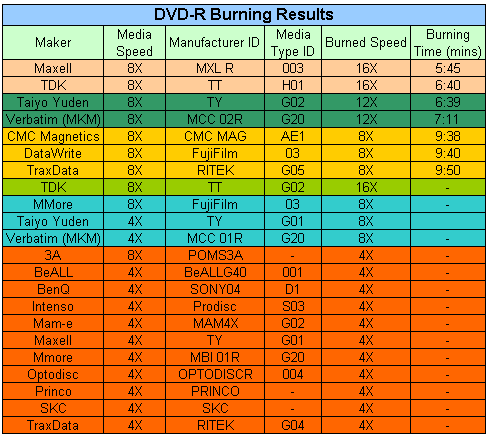

There are only a few -R media that can be recorded at 16X. The TDK 8X
media was recorded at the 16X speed but the drive could not pass the 13.5X
limit, giving
similar recording performance to that of TY 8X media recorded at 12X. On the
other hand, Maxell 16X media had the best performance of all.



Best performance was reported with TY 8X media recorded at 16X. It should
be noted that BeALL and BenQ 8X media cannot be written at 8X where only
4X is supported for these discs. For 16X media, CMC Magnetics and Philips media
could only be recorded at 8X, while Traxdata 8X and 16X media (Ritek
based) supported only 4X(!).

- Burning Tests
We burned 4315MB of data on various DVD±R, DVD±RW media. We used the maximum allowed writing speed for each disc.

Recording times seem to be the same for most DVD-R media,
with the exception of Promedia 8X media which was only 2 seconds slower. The
drive completed a successful burn at 8X in 9:29mins.
Disc Label |
Disc Information |
Max Allowed Writing Speed |
Total Recording Time (mins) |
That's 4X @ 8X |
TYG02 |
8X |
9:29 |
MKM/Verbatim 8X |
MCC 02RG20 |
8X |
9:29 |
MCC 8X |
MCC 01RG20 |
8X |
9:29 |
TraxData 4X |
RITEKG04 |
8X |
9:29 |
Maxell 4X |
MXL RG03 |
8X |
9:29 |
Promedia 8X |
Prodisc S04 |
8X |
9:31 |

With DVD+R media, best recording times came with Memorex
8X at 9:13mins. It should be noted that TraxData 4X media
was recorded at 6X in 10:21mins.
Disc Label |
Disc Information |
Max Allowed Writing Speed |
Total Recording Time (mins) |
That's 4X @ 8X |
TYG02 |
8X |
9:18 |
Memorex 8X |
CMC MAG E01 |
8X |
9:13 |
TY 8X |
YUDEN000 T02 |
8X |
9:21 |
Traxdata 8X |
RITEK R03 |
8X |
9:22 |
Maxell 8X |
MAXELL 002 |
8X |
9:19 |
Traxdata |
RICOH HJPN R01 |
8X |
10:21 |
- DVD Overburning Tests
Using Nero CD-DVD Speed, we tested if the TDK 1616N can overburn using DVD+R
and DVD-R media. The drive does not support overburning, giving the following
error
with all inserted media.


- DVD+MRW Tests
Unfortunately, the TDK 1616N does not support the Mount
Rainier feature.
12. KProbe/PlexTools Scans - Page 1
TDK 1616N Recorder - Page 12
KProbe/PlexTools Scans - Page 1
In the following screenshots you can see the PI/PIF scans for the DVD-R media
we burned with the TDK 1616N. The software we used for all measurements is
KProbe v2.4.2, and the reader is the LiteOn LDW-811S with "HS0Q patched" firmware,
being able to read DVD±R/RW media up to 8X CAV. All scans have been
performed at 8X with PI/PIF Sum8. Note that LiteOn drives cannot report PO
but only PIF errors, despite what KProbe reports. In addition, all discs have
been scanned with PX-712SA v1.05 using PlexTools v2.16 for comparison levels.
Comparing the KProbe and PlexTools scans, we can see major differences in
the reported PI/PIF error rates. The main explanation is that we have two different
readers, with different pickup/chipset combinations, scanning at different
reading speeds (8X CAV for KProbe, 2X CLV for PlexTools). It's interesting
to see the discs scanned at low & high speeds, since when the error rate
increases at a specific disc area, it should appear in both scans...else it
would be,
perhaps, a reading glitch of the tested reader.
Note: PI/PIF errors only give us a quick look at the error rate of the burned media. Those scans should be taken not as the absolute criteria of the burning quality but as an indication level.
16X DVD-R Writing Speed




- Summary
The PI/PIF scans show that the TDK 1616N performed well with the used DVD-R
media at 16X, especially with Maxell 8X media.
13. KProbe/PlexTools Scans - Page 2
TDK 1616N Recorder - Page 13
KProbe/PlexTools Scans - Page 2
In the following screenshots you can see the PI/PIF scans for the DVD-R media
we burned with the TDK 1616N. The software we used for all measurements is
KProbe v2.4.2, and the reader is the LiteOn LDW-811S with "HS0Q patched" firmware,
being able to read DVD±R/RW media up to 8X CAV. All scans have been
performed at 8X with PI/PIF Sum8. Note that LiteOn drives cannot report PO
but only PIF errors, despite what KProbe reports. In addition, all discs have
been scanned with PX-712SA v1.05 using PlexTools v2.16 for comparison levels.
Comparing the KProbe and PlexTools scans, we can see major differences in
the reported PI/PIF error rates. The main explanation is that we have two different
readers, with different pickup/chipset combinations, scanning at different
reading speeds (8X CAV for KProbe, 2X CLV for PlexTools). It's interesting
to see the discs scanned at low & high speeds, since when the error rate
increases at a specific disc area, it should appear in both scans...else it
would be, perhaps, a reading glitch of the tested reader.
Note: PI/PIF errors only give us a quick look at the error rate of the burned media. Those scans should be taken not as the absolute criteria of the burning quality but as an indication level.
12X DVD-R Writing Speed

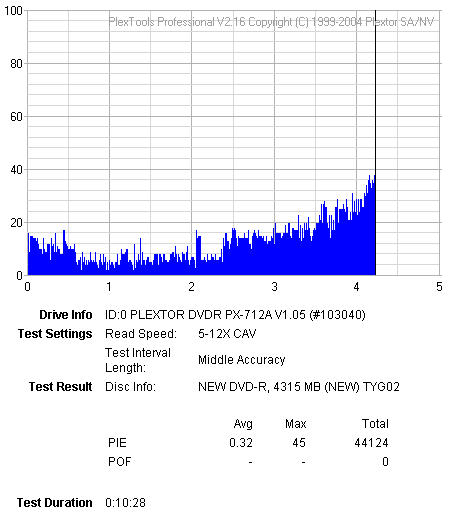


- Summary
Again, the TDK 1616N creates DVD-R with rather low PI/PIF error levels at
12X recording speed. Very good performance from TDK.
14. KProbe/PlexTools Scans - Page 3
TDK 1616N Recorder - Page 14
KProbe/PlexTools Scans - Page 3
In the following screenshots you can see the PI/PIF scans for the DVD-R media
we burned with the TDK 1616N. The software we used for all measurements is
KProbe v2.4.2, and the reader is the LiteOn LDW-811S with "HS0Q patched" firmware,
being able to read DVD±R/RW media up to 8X CAV. All scans have been
performed at 8X with PI/PIF Sum8. Note that LiteOn drives cannot report PO
but only PIF errors, despite what KProbe reports. In addition, all discs have
been scanned with PX-712SA v1.05 using PlexTools v2.16 for comparison levels.
Comparing the KProbe and PlexTools scans, we can see major differences in
the reported PI/PIF error rates. The main explanation is that we have two different
readers, with different pickup/chipset combinations, scanning at different
reading speeds (8X CAV for KProbe, 2X CLV for PlexTools). It's interesting
to see the discs scanned at low & high speeds, since when the error rate
increases at a specific disc area, it should appear in both scans...else it
would be, perhaps, a reading glitch of the tested reader.
Note: PI/PIF errors only give us a quick look at the error rate of the burned media. Those scans should be taken not as the absolute criteria of the burning quality but as an indication level.
8X DVD-R Writing Speed
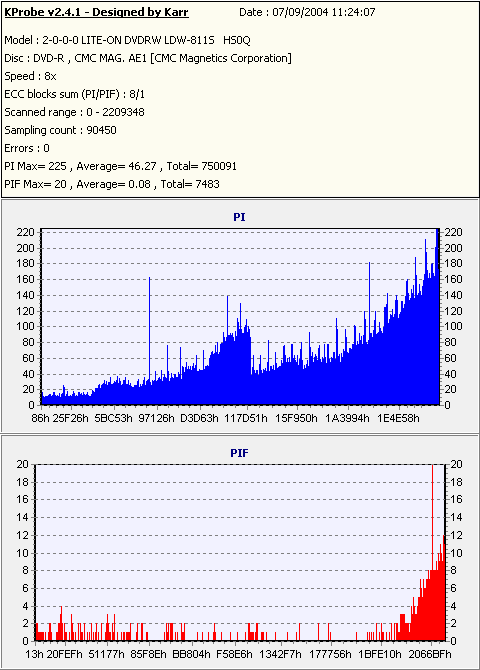





- Summary
CMC Magnetics media reported the best performance. However, the quality on
all media we tested was rather good, giving again low PI/PIF error
levels.
15. KProbe/PlexTools Scans - Page 4
TDK 1616N Recorder - Page 15
KProbe/PlexTools Scans - Page 4
In the following screenshots you can see the PI/PIF scans for the DVD-R media
we burned with the TDK 1616N. The software we used for all measurements is
KProbe v2.4.2, and the reader is the LiteOn LDW-811S with "HS0Q patched" firmware,
being able to read DVD±R/RW media up to 8X CAV. All scans have been
performed at 8X with PI/PIF Sum8. Note that LiteOn drives cannot report PO
but only PIF errors, despite what KProbe reports. In addition, all discs have
been scanned with PX-712SA v1.05 using PlexTools v2.16 for comparison levels.
Comparing the KProbe and PlexTools scans, we can see major differences in
the reported PI/PIF error rates. The main explanation is that we have two different
readers, with different pickup/chipset combinations, scanning at different
reading speeds (8X CAV for KProbe, 2X CLV for PlexTools). It's interesting
to see the discs scanned at low & high speeds, since when the error rate
increases at a specific disc area, it should appear in both scans...else it
would be, perhaps, a reading glitch of the tested reader.
Note: PI/PIF errors only give us a quick look at the error rate of the burned media. Those scans should be taken not as the absolute criteria of the burning quality but as an indication level.
16X DVD+R Writing Speed






- Summary
With DVD-R media, the TDK 1616N showed very good performance. With DVD+R media,
as shown above, the drive showed even better performance, even at 16X recording
speed.
16. KProbe/PlexTools Scans - Page 5
TDK 1616N Recorder - Page 16
KProbe/PlexTools Scans - Page 5
In the following screenshots you can see the PI/PIF scans for the DVD-R media
we burned with the TDK 1616N. The software we used for all measurements is
KProbe v2.4.2, and the reader is the LiteOn LDW-811S with "HS0Q patched" firmware,
being able to read DVD±R/RW media up to 8X CAV. All scans have been
performed at 8X with PI/PIF Sum8. Note that LiteOn drives cannot report PO
but only PIF errors, despite what KProbe reports. In addition, all discs have
been scanned with PX-712SA v1.05 using PlexTools v2.16 for comparison levels.
Comparing the KProbe and PlexTools scans, we can see major differences in
the reported PI/PIF error rates. The main explanation is that we have two different
readers, with different pickup/chipset combinations, scanning at different
reading speeds (8X CAV for KProbe, 2X CLV for PlexTools). It's interesting
to see the discs scanned at low & high speeds, since when the error rate
increases at a specific disc area, it should appear in both scans...else it
would be, perhaps, a reading glitch of the tested reader.
Note: PI/PIF errors only give us a quick look at the error rate of the burned media. Those scans should be taken not as the absolute criteria of the burning quality but as an indication level.
12X DVD+R Writing Speed


- Summary
DVD recording at 12X was supported with only one media from the discs
we tested. High PI error levels were reported, but we cannot give a good or
bad
ruling for the drive from only one media test result. Unfortunately,
according to NEC's media support list for the 3500A model, no other media is
supported at 12X at this time. However, we will test 12X writing further with
more +R discs when future firmware releases arrive. You can always check our
forum for these burning quality results.
17. KProbe/PlexTools Scans - Page 6
TDK 1616N Recorder - Page 17
KProbe/PlexTools Scans - Page 6
In the following screenshots you can see the PI/PIF scans for the DVD-R media
we burned with the TDK 1616N. The software we used for all measurements is
KProbe v2.4.2, and the reader is the LiteOn LDW-811S with "HS0Q patched" firmware,
being able to read DVD±R/RW media up to 8X CAV. All scans have been
performed at 8X with PI/PIF Sum8. Note that LiteOn drives cannot report PO
but only PIF errors, despite what KProbe reports. In addition, all discs have
been scanned with PX-712SA v1.05 using PlexTools v2.16 for comparison levels.
Comparing the KProbe and PlexTools scans, we can see major differences in
the reported PI/PIF error rates. The main explanation is that we have two different
readers, with different pickup/chipset combinations, scanning at different
reading speeds (8X CAV for KProbe, 2X CLV for PlexTools). It's interesting
to see the discs scanned at low & high speeds, since when the error rate
increases at a specific disc area, it should appear in both scans...else it
would be, perhaps, a reading glitch of the tested reader.
Note: PI/PIF errors only give us a quick look at the error rate of the burned media. Those scans should be taken not as the absolute criteria of the burning quality but as an indication level.
8X DVD+R Writing Speed














- Summary
All former NEC based drives performed excellently when 8X burned media was
tested. The TDK 1616N is no exception. Media quality seems to be further
improved, comparing it with the TDK 882N drive and the NEC ND-25x0 series.
18. KProbe/PlexTools Scans - Page 7
TDK 1616N Recorder - Page 18
KProbe/PlexTools Scans - Page 7
In the following screenshots you can see the PI/PIF scans for the DVD-R media
we burned with the TDK 1616N. The software we used for all measurements is
KProbe v2.4.2, and the reader is the LiteOn LDW-811S with "HS0Q patched" firmware,
being able to read DVD±R/RW media up to 8X CAV. All scans have been
performed at 8X with PI/PIF Sum8. Note that LiteOn drives cannot report PO
but only PIF errors, despite what KProbe reports. In addition, all discs have
been scanned with PX-712SA v1.05 using PlexTools v2.16 for comparison levels.
Comparing the KProbe and PlexTools scans, we can see major differences in
the reported PI/PIF error rates. The main explanation is that we have two different
readers, with different pickup/chipset combinations, scanning at different
reading speeds (8X CAV for KProbe, 2X CLV for PlexTools). It's interesting
to see the discs scanned at low & high speeds, since when the error rate
increases at a specific disc area, it should appear in both scans...else it
would be, perhaps, a reading glitch of the tested reader.
Note: PI/PIF errors only give us a quick look at the error rate of the burned media. Those scans should be taken not as the absolute criteria of the burning quality but as an indication level.
DVD+RW and DVD-RW Media








- Summary
Good quality performance was expected with DVD+RW and DVD-RW media, since
the writing speed is reduced to 4X. The TDK 1616N did not disappoint us, posting
again, low PI/PIF error levels.
19. DVD+R DL - Page 1
TDK 1616N Recorder - Page 19
DVD+R DL - Page 1
- Writing Tests
We burned some DVD+R DL discs with DVD-Video content. The source disc was "Gladiator Movie - Special Edition" disc1 with a total size of 6.86GB. First we transferred the movie to the hard disc with DVD Decrypter as ISO format (single file). We used Double Layer media provided by Ritek and Verbatim (MKM). The following picture shows the media code of these Double Layer discs.


We used CopyToDVD v3.0.29.48. For our test, we used the "Movie & Pictures" option, and then the "Write DVD Video". The software prompts us to select Video_TS/ISO image folder. We chose the "GLADIATOR.ISO" image and we selected the TDK 1616N burner.

After pressing "OK", the burning procedure started without any unexpected
delays (such as 50secs delay with the LiteON 832S). It should be noted that
we did not change the booktype setting in order to check the default booktype
setting of the TDK drive.

The writing process was finished after 22:51 minutes. The
average speed was 3.88X as reported by CopyToDVD software.
The recorded disc was in DVD+R9 format.

We then changed the default booktype setting of DVD+R9 media to DVD-ROM using the latest DVDInfoPro software:

The second disc we burned was the Verbatim Double Layer media. Recording time
was further reduced to 22:48 mins and the average speed reported
was 3.90X:

For comparison reasons, we post DL burning results with other
writers, with the same disc content and same recording software:
Drive |
Time (mins) |
NEC 2510A |
37:17 |
BenQ DW1600A DL |
40:16 |
BenQ DW830A |
39:14 |
LiteON SOHW-832S DVD+R DL BookType |
38:33 |
LiteON SOHW-832S DVD-ROM BookType |
38:36 |
|
|
LG GSA-4120B |
38:12 |
|
23:10 |
ASUS DRW-1604P (2.4X) |
38:08 |
|
23:10 |
Pioneer DVR-108A (2.4X) |
|
TDK 1616N |
22:48 / 22:51 |
BenQ DW1620A |
40:03 |
The TDK 1616N is the fastest Double Layer recorder of all, surpassing
the Pioneer and Asus 4X Double Layer recorders.
20. DVD+R DL - Page 2
TDK 1616N Recorder - Page 20
DVD+R DL - Page 2
- Writing Quality
In order to test the TDK 1616N DVD+R DL writing quality, instead of our
usual reader (LiteOn LDW-811S), we used
the LiteOn SOHD-167T with firmware 9S13. We
also used the Plextor PX-712SA drive and PlexTools, and were able to scan
the DVD+R DL media.
Using KProbe v2.4.2, we got a very good scan, indicating again, good quality
performance from the drive with the DL media recorded. Notice that discs are
not read at 3~8 CAV but at 2.5X~5X CAV (DVD+R DL media).
- Ritek Double Layer media @ 4X


- Verbatim Double Layer media @ 4X


The reported PI error rates were lower than the 280 limit according to the
KProbe scans. Verbatim media exceeded the 280 limit when Verbatim media was
tested
at the layer switch point. In general, the TDK 1616N gave again an image
of a very good quality burner, even with Double Layer media.
In the following images, you can see for reference reasons, the media info
reported by DVDInfoPro software for the Double Layer discs we burned. We reminde
you that Verbatim media was burned with DVD-ROM booktype, while Ritek media
with DVD+R DL booktype.


- Compatibility
We were not surprised to see that the DVD+R9 media was not compatible with most stand-alone dvd players. On the other hand, changing the default booktype to DVD-ROM ensures maximum compatibility.
21. BookType Setting
TDK 1616N Recorder - Page 21
BookType Setting
The TDK 1616N allows the booktype setting to be changed, but there is no official
TDK utility to do that. There is no way to change the booktype with Nero Burning
Rom 6.3.1.20, since there is no booktype option in the "choose recorder" tab.
There are few utilities that can be used to change the booktype setting, but unfortunately, only DVD+R DL changes are supported for now.
Using the latest DVDInfoPro software, we were able to see the default setting of the drive, which was DVD+R DL.
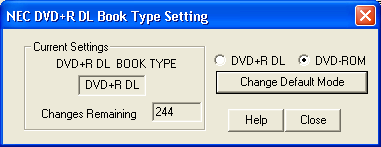
We then successfully changed the booktype setting to DVD-ROM.

We then used the WinBType booktype setting utility. Again, we had no problem
changing the default booktype to DVD-ROM.



22. Conclusion
TDK 1616N Recorder - Page 22
Conclusion
 The
TDK 1616N is the first 16X Dual DL DVD recorder released by TDK, and our impressions
of this drive are very good. Most users will like the black stylish front panel
that TDK uses for these drives.
The
TDK 1616N is the first 16X Dual DL DVD recorder released by TDK, and our impressions
of this drive are very good. Most users will like the black stylish front panel
that TDK uses for these drives.
The
new 1616N model is a step up on previous TDK
models with less reading errors being reported with the various test discs.
However,
the
DAE speed
is
still low,
compared
to other recorders available on the market. The DVD error correction was
satisfactory,
while the drive needs further improvements with the CD format, since high
reading errors were produced when reading the Abex TCD-721R/726 test discs.
The drive cannot make SafeDisc 2.60+
backups, due to the NEC chipsets used and cannot recognize 99mins discs.

When CD-R media was used to test writing performance, we discovered that some well known media could not be burned at high speed (48X) but only at 32X. For example, TY CD-R media is supported only at 32X. This produces better quality burns, but speed is reduced. With 48X recording speed, writing quality was reduced, and these discs reported high jitter values. This is a point that TDK should consider for the next firmware release.

On the other hand, DVD recording performance was way better than CD-R media
recording. Very fast recording times with 16X certified media, and good times
with 8X media that were recorded at 16X or 12X.
Media quality measurements indicated that TDK keeps on improving recording
quality and low PI/PO error levels were reported. Excellent performance from
TDK! However, there are small exceptions, like Ritek 16X media that can be
recorded only at 4X, and CMC and Philips 16X media at 8X.
With DVD+R Double Layer discs, the TDK 1616N is the fastest drive at 22:51
mins, while the recording quality with Verbatim and Ritek media was very good.
The
default DVD-ROM booktype (DVD+R DL media) offers the highest compability with
DVD Players, while the announcement of the upcoming v2.x8 firmware supporting
default DVD-ROM booktype for +R/+RW media will make users happy!
An overall very good buy with an expected low price from TDK, makes us reccomend
the drive to all users who desire a fast and reliable burner.

- The Good
- Excellent CD writing quality at 32X with low Jitter values
- Very good Single Layer DVD writing quality
- Supports CD-Text (reading/writing)
- Supports audio protected discs
- High C2% accuracy
- Fast recording with Double Layer media and very good writing quality
- Good DVD error correction capability
- Can read/rip 90mins Audio CDs
- Can overburn up to 88mins CDs
- The Bad
- Mount Rainier is not supported
- Cannot recognize 99min Audio CD's
- Cannot create working backups with SafeDisc protected games over v2.60
- DAE speed only up to 32X
- Slow ripping CSS DVD-Video performance
- Cannot overburn DVD recordable media
- Medium CD writing quality at 48X
- Like To be fixed
- Official firmware release to support booktype setting for +R/+RW media
(planned to be fixed with upcoming 2.80 firmware release)
- Better writing quality with 48X CD-R media